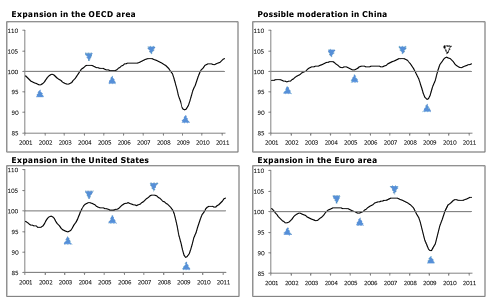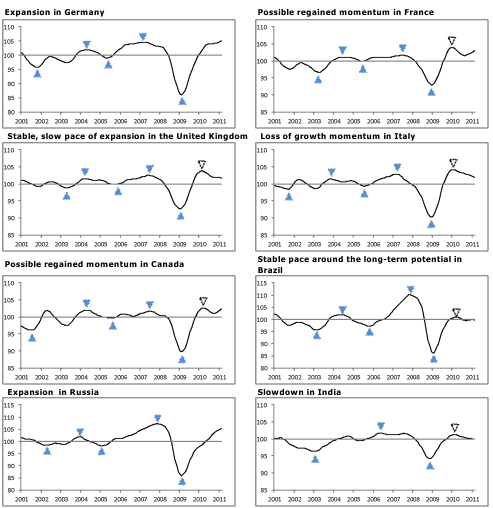The OECD tonight (Australian time) released its composite leading indicators (CLIs) for February 2011, designed to anticipate turning points in economic activity relative to trend. They continue pointing to expansion in most OECD countries. CLIs continue pointing to robust expansion relative to trend in Germany and the United States and a possible regained momentum in France and […]
The OECD tonight (Australian time) released its composite leading indicators (CLIs) for February 2011, designed to anticipate turning points in economic activity relative to trend. They continue pointing to expansion in most OECD countries.
CLIs continue pointing to robust expansion relative to trend in Germany and the United States and a possible regained momentum in France and Canada. The CLI for the United Kingdom points to a slow but stable pace of expansion. The CLI for Italy points to a loss of momentum in economic activity. Because of the exceptional circumstances the country is facing, it is not possible to provide reliable estimates of the CLI for Japan at this stage.
The CLI for China points to a possible moderation in economic activity. For Brazil the CLI indicates that economic activity should remain near its long-term potential. The CLI for India continues pointing to a slowdown and the CLI for Russia continues pointing to expansion.
CLIs continue pointing to robust expansion relative to trend in Germany and the United States and apossible regained momentum in France and Canada. The CLI for the United Kingdom points to a slow butstable pace of expansion. The CLI for Italy points to a loss of momentum in economic activity.
Because of the exceptional circumstances the country is facing, it is not possible to provide reliable estimatesof the CLI for Japan at this stage.
The CLI for China points to a possible moderation in economic activity. For Brazil the CLI indicates thateconomic activity should remain near its long-term potential. The CLI for India continues pointing to aslowdown and the CLI for Russia continues pointing to expansion.

 The above graphs show country specific composite leading indicators (CLIs). Turning points of CLIs tend to precede turning points in economic activity relative to long-term trend by approximately six months. The horizontal line at 100 represents the long-term trend of economic activity. Shaded triangles mark confirmed turning-points of the CLI. Blank triangles mark provisional turning-points that may be reversed.
The above graphs show country specific composite leading indicators (CLIs). Turning points of CLIs tend to precede turning points in economic activity relative to long-term trend by approximately six months. The horizontal line at 100 represents the long-term trend of economic activity. Shaded triangles mark confirmed turning-points of the CLI. Blank triangles mark provisional turning-points that may be reversed.

 The above graphs show country specific composite leading indicators (CLIs). Turning points of CLIs tend to precede turning points in economic activity relative to long-term trend by approximately six months. The horizontal line at 100 represents the long-term trend of economic activity. Shaded triangles mark confirmed turning-points of the CLI. Blank triangles mark provisional turning-points that may be reversed.
The above graphs show country specific composite leading indicators (CLIs). Turning points of CLIs tend to precede turning points in economic activity relative to long-term trend by approximately six months. The horizontal line at 100 represents the long-term trend of economic activity. Shaded triangles mark confirmed turning-points of the CLI. Blank triangles mark provisional turning-points that may be reversed.






Crikey is committed to hosting lively discussions. Help us keep the conversation useful, interesting and welcoming. We aim to publish comments quickly in the interest of promoting robust conversation, but we’re a small team and we deploy filters to protect against legal risk. Occasionally your comment may be held up while we review, but we’re working as fast as we can to keep the conversation rolling.
The Crikey comment section is members-only content. Please subscribe to leave a comment.
The Crikey comment section is members-only content. Please login to leave a comment.